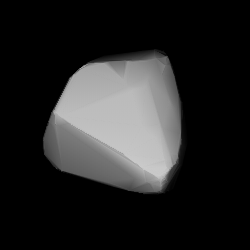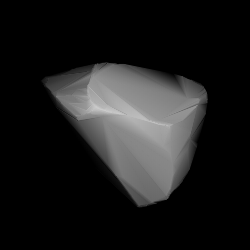Related Research Articles
971 Alsatia, provisional designation 1921 LF, is a carbonaceous background asteroid from the central region of the asteroid belt, approximately 60 kilometers in diameter. It was discovered on 23 November 1921, by French astronomer Alexandre Schaumasse at Nice Observatory in southeastern France. The asteroid was named after the French province Alsace.
2023 Asaph, provisional designation 1952 SA, is a dark asteroid from the outer regions of the asteroid belt, approximately 21 kilometers in diameter. It was discovered on 16 September 1952, by astronomers of the Indiana Asteroid Program at Goethe Link Observatory in Indiana, United States.
1027 Aesculapia, provisional designation A923 YO11, is a Themistian asteroid from the outer region of the asteroid belt, approximately 33 kilometers in diameter.

1042 Amazone, provisional designation 1925 HA, is a dark asteroid and slow rotator in the outer asteroid belt, approximately 70 kilometers in diameter. It was discovered on 22 April 1925, by German astronomer Karl Reinmuth at Heidelberg Observatory in southern Germany. It is named after the Amazons from Greek mythology.
1084 Tamariwa, provisional designation 1926 CC, is a carbonaceous background asteroid approximately 27 kilometres in diameter from the central regions of the asteroid belt. It was discovered on 12 February 1926, by Soviet astronomer Sergey Belyavsky at the Simeiz Observatory on the Crimean peninsula. The asteroid was named after female paratrooper Tamara Ivanova, who died at an early age.

1132 Hollandia, provisional designation 1929 RB1, is a stony asteroid from the middle region of the asteroid belt, approximately 27 kilometers in diameter. It was discovered on 13 September 1929, by Dutch astronomer Hendrik van Gent at Leiden Southern Station, annex to the Johannesburg Observatory in South Africa. It was named for the region Holland in the Netherlands.

9936 Al-Biruni, provisional designation 1986 PN4, is a carbonaceous asteroid from the outer region of the asteroid belt, approximately 24 kilometers in diameter. It was discovered on 8 August 1986, by Belgian and Bulgarian astronomers Eric Elst and Violeta Ivanova at the Rozhen Observatory, located in Bulgaria's Smolyan province near the border to Greece. It was named for Persian medieval scholar Al-Biruni.
1194 Aletta, provisional designation 1931 JG, is a carbonaceous asteroid from the outer region of the asteroid belt, approximately 55 kilometers in diameter. It was discovered on 13 May 1931, by South African astronomer Cyril Jackson at Johannesburg Observatory in South Africa. It was later named after the discoverer's wife Aletta Jackson.
3037 Alku, provisional designation 1944 BA, is a carbonaceous asteroid from the central region of the asteroid belt, approximately 20 kilometers in diameter. It was discovered on 17 January 1944, by Finnish astronomer Yrjö Väisälä at Turku Observatory in Southwest Finland.

1294 Antwerpia (prov. designation: 1933 UB1) is a dark background asteroid from the central regions of the asteroid belt. It was discovered on 24 October 1933, by astronomer Eugène Delporte at the Royal Observatory of Belgium in Uccle. The carbonaceous C-type asteroid has a rotation period of 6.6 hours and measures approximately 35 kilometers (22 miles) in diameter. It was named for the Belgian city of Antwerp.
3915 Fukushima, provisional designation 1988 PA1, is a carbonaceous asteroid from the inner regions of the asteroid belt, approximately 21 kilometers in diameter.
1271 Isergina, provisional designation 1931 TN, is a carbonaceous background asteroid from the outer regions of the asteroid belt, approximately 45 kilometers in diameter. It was discovered on 10 October 1931, by Soviet astronomer Grigory Neujmin at the Simeiz Observatory on the Crimean peninsula. The asteroid was named after Crimean physician and friend of the discoverer, Pyotr Isergin.
1384 Kniertje, provisional designation 1934 RX, is a dark Adeonian asteroid from the central regions of the asteroid belt, approximately 26 kilometers in diameter. It was discovered on 9 September 1934, by Dutch astronomer Hendrik van Gent at the Union Observatory in Johannesburg, South Africa. The asteroid was named after a character in the Dutch play Op Hoop van Zegen by Herman Heijermans.
1264 Letaba, provisional designation 1933 HG, is a carbonaceous asteroid and possible tumbler from the background population of the outer asteroid belt, approximately 70 kilometers in diameter. It was discovered on 21 April 1933, by South African astronomer Cyril Jackson at the Union Observatory in Johannesburg. The asteroid was named for the Letaba River in eastern South Africa.

1361 Leuschneria, provisional designation 1935 QA, is a carbonaceous asteroid from the outer regions of the asteroid belt, approximately 30 kilometers in diameter. It was discovered on 30 August 1935, by Belgian astronomer Eugène Delporte at Uccle Observatory in Belgium, and named after American astronomer Armin Otto Leuschner.

1175 Margo, provisional designation 1930 UD, is a stony background asteroid from the outermost regions of the asteroid belt, approximately 24 kilometers in diameter. It was discovered on 17 October 1930, by astronomer Karl Reinmuth at the Heidelberg-Königstuhl State Observatory in southwest Germany. The meaning of the asteroids's name is unknown.

1582 Martir, provisional designation 1950 LY, is a carbonaceous background asteroid from the outer regions of the asteroid belt, approximately 37 kilometers in diameter. It was discovered on 15 June 1950, by Argentine astronomer Miguel Itzigsohn at the La Plata Astronomical Observatory in Argentina. The asteroid was named after the First Lady of Argentina, Eva Perón.
1696 Nurmela, provisional designation 1939 FF, is a Baptistina asteroid from the inner regions of the asteroid belt, approximately 10 kilometers in diameter. It was discovered on 18 March 1939, by Finnish astronomer Yrjö Väisälä at Turku Observatory in Southwest Finland, and named after Finnish academician Tauno Nurmela. The possibly elongated asteroid has a rotation period of 3.15 hours.

2120 Tyumenia is a dark background asteroid, approximately 45 kilometers in diameter, located in the outer regions of the asteroid belt. It was discovered on 9 September 1967, by Soviet astronomer Tamara Smirnova at the Crimean Astrophysical Observatory in Nauchnyj, on the Crimean peninsula. The asteroid was named for the now Russian district of Tyumen Oblast in Western Siberia.
1708 Pólit, provisional designation 1929 XA, is a very dark asteroid from the outer region of the asteroid belt, approximately 29 kilometers in diameter. It was discovered on 30 November 1929, by Spanish astronomer of Catalan origin Josep Comas i Solà at the Fabra Observatory in Barcelona, and was later named after Catalan astronomer Isidre Pòlit i Boixareu.
References
- 1 2 3 4 5 "JPL Small-Body Database Browser: 1305 Pongola (1928 OC)" (2017-10-29 last obs.). Jet Propulsion Laboratory . Retrieved 19 December 2017.
- 1 2 3 Schmadel, Lutz D. (2007). "(1305) Pongola". Dictionary of Minor Planet Names . Springer Berlin Heidelberg. p. 107. doi:10.1007/978-3-540-29925-7_1306. ISBN 978-3-540-00238-3.
- 1 2 3 4 5 6 7 8 "LCDB Data for (1305) Pongola". Asteroid Lightcurve Database (LCDB). Retrieved 19 December 2017.
- 1 2 "Asteroid 1305 Pongola – Proper Elements". AstDyS-2, Asteroids – Dynamic Site. Retrieved 29 October 2019.
- 1 2 3 4 Masiero, Joseph R.; Grav, T.; Mainzer, A. K.; Nugent, C. R.; Bauer, J. M.; Stevenson, R.; et al. (August 2014). "Main-belt Asteroids with WISE/NEOWISE: Near-infrared Albedos". The Astrophysical Journal. 791 (2): 11. arXiv: 1406.6645 . Bibcode:2014ApJ...791..121M. doi:10.1088/0004-637X/791/2/121.
- 1 2 3 4 5 Usui, Fumihiko; Kuroda, Daisuke; Müller, Thomas G.; Hasegawa, Sunao; Ishiguro, Masateru; Ootsubo, Takafumi; et al. (October 2011). "Asteroid Catalog Using Akari: AKARI/IRC Mid-Infrared Asteroid Survey". Publications of the Astronomical Society of Japan. 63 (5): 1117–1138. Bibcode:2011PASJ...63.1117U. doi: 10.1093/pasj/63.5.1117 . (online, AcuA catalog p. 153)
- 1 2 3 4 5 Mainzer, A.; Grav, T.; Masiero, J.; Hand, E.; Bauer, J.; Tholen, D.; et al. (November 2011). "NEOWISE Studies of Spectrophotometrically Classified Asteroids: Preliminary Results". The Astrophysical Journal. 741 (2): 25. arXiv: 1109.6407 . Bibcode:2011ApJ...741...90M. doi:10.1088/0004-637X/741/2/90.
- 1 2 Behrend, Raoul. "Asteroids and comets rotation curves – (1305) Pongola". Geneva Observatory. Retrieved 19 December 2017.
- 1 2 3 4 5 Binzel, R. P. (October 1987). "A photoelectric survey of 130 asteroids". Icarus. 72 (1): 135–208. Bibcode:1987Icar...72..135B. doi:10.1016/0019-1035(87)90125-4. ISSN 0019-1035 . Retrieved 19 December 2017.
- 1 2 Sada, Pedro V.; Olguin, Lorenzo; Saucedo, Julio C.; Loera-Gonzalez, Pablo; Cantu-Sanchez, Laura; Garza, Jaime R.; et al. (July 2017). "Results of the 2016 Mexican Asteroid Photometry Campaign". The Minor Planet Bulletin. 44 (3): 239–242. Bibcode:2017MPBu...44..239S. ISSN 1052-8091 . Retrieved 19 December 2017.
- 1 2 3 Waszczak, Adam; Chang, Chan-Kao; Ofek, Eran O.; Laher, Russ; Masci, Frank; Levitan, David; et al. (September 2015). "Asteroid Light Curves from the Palomar Transient Factory Survey: Rotation Periods and Phase Functions from Sparse Photometry". The Astronomical Journal. 150 (3): 35. arXiv: 1504.04041 . Bibcode:2015AJ....150...75W. doi:10.1088/0004-6256/150/3/75 . Retrieved 19 December 2017.
- 1 2 Ditteon, Richard; Horn, Lauren; Kamperman, Amy; Vorjohan, Bradley; Kirkpatrick, Elaine (January 2012). "Asteroid Lightcurve Analysis at the Oakley Souther Sky Observatory: 2011 April-May". The Minor Planet Bulletin. 39 (1): 26–28. Bibcode:2012MPBu...39...26D. ISSN 1052-8091 . Retrieved 19 December 2017.
- 1 2 3 Mansego, Enrique Arce; Rodriguez, Pedro Brines; de Haro, Juan Lozano; Chiner, Onofre Rodrigo; Silva, Alvaro Fornas; Porta, David Herrero; et al. (October 2016). "Eighteen Asteroids Lightcurves at Asteroides Observers (OBAS) - MPPD: 2016 March-May". The Minor Planet Bulletin. 43 (4): 332–336. Bibcode:2016MPBu...43..332M. ISSN 1052-8091 . Retrieved 19 December 2017.
- 1 2 "1305 Pongola (1928 OC)". Minor Planet Center. Retrieved 19 December 2017.